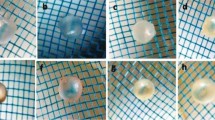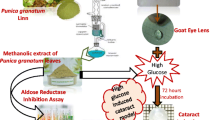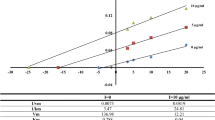Abstract
The present study was aimed to investigate the protective effect of Pterocarpus marsupium bark extracts against cataract in streptozotocin-induced diabetic male albino rats. Aldose reductase is a key enzyme in the intracellular polyol pathway, which plays a major role in the development of diabetic cataract. Rats were divided into five groups as normal control, diabetic control, and diabetic control treated with different concentrations of Pterocarpus marsupium bark extracts. Presence of major constituents in Pterocarpus marsupium bark extract was performed by qualitative analysis. Body weight changes, blood glucose, blood insulin, and reduced glutathione (GSH) and aldose reductase mRNA and protein expression were determined. Rat body weight gain was noted following treatment with bark extracts. The blood glucose was reduced up to 36% following treatment with bark extracts. The blood insulin and tissue GSH contents were substantially increased more than 100% in diabetic rats following treatment with extracts. Aldose reductase activity was reduced up to 79.3% in diabetic rats following treatment with extracts. Vmax, Km, and Ki of aldose reductase were reduced in the lens tissue homogenate compared to the diabetic control. Aldose reductase mRNA and protein expression were reduced more than 50% following treatment with extracts. Treatment with Pterocarpus marsupium bark was able to normalize these levels. Taking all these data together, it is concluded that the use of Pterocarpus marsupium bark extracts could be the potential therapeutic approach for the reduction of aldose reductase against diabetic cataract.





Similar content being viewed by others
References
Balic M, Rapp N, Stanzer S, Lin H, Strutz J, Szkandera J, Daidone MG, Samonigg H, Cote RJ, Dandachi N (2011) Novel immunofluorescence protocol for multimarker assessment of putative disseminating breast cancer stem cells. Appl Immunohistochem Mol Morphol 19:33–40
Corso AD, Cappiello M, Mura U (2008) From a dull enzyme to something else: facts and perspectives regarding aldose reductase. Curr Med Chem 15:1452–1461
Daniellou R, Zheng H, Palmer DRJ (2006) Kinetics of the reaction catalyzed by inositol dehydrogenase from Bacillus subtilis and inhibition by fluorinated substrate analogs. Can J Chem 84:522–527
Gabbay KH (1973) The sorbitol pathway and the complications of diabetes. N Engl J Med 288:831–836
Ghahary A, Luo JM, Gong YW, Chakrabarti S, Sima AA, Murphy LJ (1989) Increased renal aldose reductase activity: immunoreactivity and mRNA in streptozotocin-induced diabetic rats. Diabetes 38:1067–1071
Grover JK, Yadav S, Vats V (2002) Medicinal plants of India with anti-diabetic potential. J Ethnopharmacol 81:81–100
Harborne JB (1998) Phytochemical methods: a guide to modern techniques of plant analysis, 3rd edn. Chapman & Hall Pub, London
Harding JJ (1992) Pharmacological treatment strategies in age-related cataracts. Drugs Aging 2(4):287–300
Hariharan RS, Venkataraman S, Sunitha P, Rajalakshmi S, Samal KC, Routray BM, Jayakumar RV, Baiju K, Satyavati GV, Muthuswamy V, Gupta AK (2005) Efficacy of vijayasar (Pterocarpus marsupium) in the treatment of newly diagnosed patients with type 2 diabetes mellitus: a flexible-dose double-blind, multicenter randomized controlled trial. Diabetologia Croatica 34:13–20
Hung HY, Qian K, Morris Natschke SL, Hsu CS, Lee KH (2012) The Recent discovery of plant-derived anti-diabetic natural products. Nat Prod Rep 29:580–606
Jung HA, Kim YS, Choi JS (2009) Quantitative HPLC analysis of two key flavonoids and inhibitory activities against aldose reductase from different parts of the Korean thistle, Cirsium maackii. Food Chem Toxicol 47(11):2790–2797
Klein R, Klein BE, Moss SE (1992) Epidemiology of proliferative diabetic retinopathy. Diabetic Care 15:1875–1891
Koksal B (2015) Effect of streptozotocin on plasma insulin levels of rats and mice: a meta-analysis study. Open Access Maced J Med Sci 3:380–383
Kumar R, Patel DK, Laloo D, Sairam K, Hemalatha S (2011) Inhibitory effect of two Indian medicinal plants on aldose reductase of rat lens in vitro. Asian Pac J Trop Med 4:694–697
Lee H (2002) Inhibitory activity of Cinnamomum cassia bark-derived component against rat lens aldose reductase. J Pharm Pharmaceut Sci 5(3):226–230
Lou MF, Dickerson JE Jr (1992) Protein-thiol mixed disulfides in the human lens. Exp Eye Res 55:889–896
Lowry OH, Rosebrough NJ, Farr AL, Randall RJ (1951) Protein measurement with the Folin phenol reagent. J Biol Chem 193:265–275
Masatoshi M, Nobuo O, Shinichi S, Shahabuddin A, Jen-Yue T, Peter FK, Sanai S (2001) The role of aldose reductase in sugar cataract formation: aldose reductase plays a key role in lens epithelial cell death (apoptosis). Chem Biol Interact 130–132:617–625
Massfelder T, Lang H, Schordan E, Lindner V, Rothhut S, Welsch S, Simon-Assmann P, Barthelmebs M, Jacqmin D, Helwig JJ (2004) Parathyroid hormone-related protein is an essential growth factor for human clear cell renal carcinoma and a target for the von Hippel-Lindau tumor suppressor gene. Cancer Res 64:180–188
Muthuraman P, Kim DH (2016) Therapeutic potential of cyanobacteria against streptozotocin-induced diabetic rats. 3 Biotech 6(1):94
Muthuraman P, Srikumar K (2009) A comparative study on the effect of homobrassinolide and gibberellic acid on lipid peroxidation and antioxidant status in normal and diabetic rats. J Enzyme Inhib Med Chem 24:1122–1127
Muthuraman P, Senthilkumar R, Srikumar K (2009) Alterations in beta-islets of Langerhans in alloxan-induced diabetic rats by marine Spirulina platensis. J Enzyme Inhib Med Chem 24:1253–1256
Narayana DB, Dobriyal RM (2000) Complimentary medicines and 21st-century therapeutics: challenges for pharmacologist. In: Gupta SK (ed) Pharmacology and therapeutics in the new millennium. Narosa Publishing House, New Delhi, pp 326–335
Pastene E, Avello M, Letelier MM, Sanzana E, Vega M, González M (2007) Preliminary studies on antioxidant and anti-cataract activities of Cheilanthes glauca (Cav.) Mett. through various in vitro models. Electron J Food Plants Chem 2(1):1–8
Patel MB, Mishra SM (2009) Aldose reductase inhibitory activity of a C-glycosidic flavonoid derived from Enicostemma hyssopifolium. J Altern Complement Med 6:1–17
Reddy GB, Satyanarayana A, Balakrishna N, Ayyagari R, Padma M, Viswanath K et al (2008) Erythrocyte aldose reductase activity and sorbitol levels in diabetic retinopathy. Mol Vis 14:593–601
Schemmel K, Padiyara R, D’souza J (2010) Aldose reductase inhibitors in the treatment of diabetic peripheral neuropathy: a review. J Diabetes Complicat 24:354–360
Schwartz JE, Durham BC (1979) Evaluation of three methods of protein analysis for serum and heart homogenates. Ann Clin Lab Sci 9:139–143
Scotti L, Fernandes MB, Muramatsu E, Pasqualoto KFM, Emereciano VP, Tavares LC et al (2011) Self-organizing maps and volsurf approach to predict aldose reductase inhibition by flavonoid compounds. Rev Bras Phcog 21(1):170–180
Srivastava Y, Venkatakrishna-Bhatt H, Verma Y (1988) Effect of Momordica charantia Linn. pomous aqueous extract on cataractogenesis in murrin alloxan diabetics. Pharmacol Res Commun 20:201–209
Thylefors B (1990) The World Health Organization’s program for the prevention of blindness. Int J Ophthalmol 14:211–219
Vats V, Yadav SP, Biswas NR, Grover JK (2004) Anti-cataract activity of Pterocarpus marsupium bark and Trigonella foenum-graecum seeds extract in alloxan diabetic rats. J Ethnopharmacol 93:289–294
Wang Z, Yang Y, Xiang X, Zhu Y, Men J, He M (2010) Estimation of the normal range of blood glucose in rats. Wei Sheng Yan Jiu 39:133–137
Warrier PK (1995) Ocimum basilicum Linn. In: Warrier PK, Nambiar VPK, Ramankutty C (eds) Indian medicinal plants. Orient Longman Limited, Madras, pp 160–163
Zhu C (2013) Aldose reductase inhibitors as potential therapeutic drugs of diabetic complications. In: Oguntibeju OO (ed) Diabetes mellitus-insights and perspectives. InTech, Crotia, pp 17–46
Author information
Authors and Affiliations
Corresponding author
Ethics declarations
Conflict of interest
Authors declare that they have no conflict of interest.
Rights and permissions
About this article
Cite this article
Xu, Y., Zhao, Y., Sui, Y. et al. Protective effect of Pterocarpus marsupium bark extracts against cataract through the inhibition of aldose reductase activity in streptozotocin-induced diabetic male albino rats. 3 Biotech 8, 188 (2018). https://doi.org/10.1007/s13205-018-1210-6
Received:
Accepted:
Published:
DOI: https://doi.org/10.1007/s13205-018-1210-6




